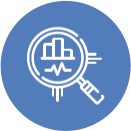Our Alumni Work At

"AI to contribute $16.1 trillion to the global economy by 2030. With 133 million more engaging, less repetitive jobs AI to change the workforce." - (Source). Data Science with Artificial Intelligence (AI) is a revolution in the business industry.. AI is potentially being adopted in automating many jobs leading to higher productivity, less cost, and extensible solutions. It is reported by PWC in a publication that about 50% of human jobs will be taken away by the AI in the next 5 years.
There is already a huge demand for AI specialists and this demand will be exponentially growing in the future. In the past few years, careers in AI have boosted concerning the demands of industries that are digitally transformed. The report of 2018 states that the requirements for AI skills have drastically doubled in the last three years, with job openings in the domain up to 119%.
FAQs for Data Science Certification Course Training in Bhubaneswar
360DigiTMG offers a comprehensive data science course in Bhubaneswar that covers various aspects of data science, including data analysis, machine learning, data visualisation and more.
While there are no specific prerequisites, basic knowledge of programming languages like Python and statistics can be beneficial for better understanding the concepts taught during the course.
The data science course training at 360DigiTMG in Bhubaneswar is led by experienced and industry-leading instructors with extensive knowledge and practical experience in the field of data science.
The course covers a wide range of topics, including data preprocessing, exploratory data analysis (EDA), machine learning algorithms, data visualisation, big data technologies, Predictive modelling techniques, deep learning algorithms, generative AI, ChatGPT and more.
Yes, the data science course at 360DigiTMG emphasises hands-on learning. Students will work on real-world projects and case studies to apply the concepts they learn during the course.
No, work experience is not typically a mandatory requirement to join the Data Science Course Training at 360DigiTMG in Bhubaneswar. The course is designed to cater to both fresh graduates and working professionals looking to upskill or transition into the field of data science. However, having prior work experience, especially in relevant domains, can be an added advantage during the course and can further enhance your learning experience.
Yes, students from non-technical backgrounds can apply for the Data Science Course Training at 360DigiTMG in Bhubaneswar. As mentioned earlier, having a bachelor's degree in any discipline is generally sufficient for eligibility. The course is designed to accommodate learners from diverse backgrounds, and it often includes introductory sessions on programming and other technical concepts to help students grasp the fundamentals of data science.
There are typically no specific age restrictions for joining the Data Science Course Training at 360DigiTMG in Bhubaneswar. The course is open to both recent graduates and experienced professionals who wish to pursue a career in data science or enhance their existing skills. As long as the candidates meet the educational and skill prerequisites, they are eligible to enrol in the course.
360DigiTMG offers both online and offline data science courses, giving students the flexibility to choose the mode of learning that suits them best.
360DigiTMG's data science course stands out due to its comprehensive curriculum, hands-on approach, experienced instructors, and industry-relevant projects, which prepares students to meet the demands of the rapidly evolving data science field.
Yes, the data science certificate awarded upon completing the course at 360DigiTMG Bhubaneswar typically includes details about the topics covered during the training. This can be a valuable reference for potential employers and recruiters.
Yes, 360DigiTMG is a reputable training institute with a strong track record of producing skilled data science professionals. The certificate holds value in the industry and is recognized by various employers.
Absolutely! You can proudly display your data science course certificate from 360DigiTMG on platforms like LinkedIn to demonstrate your commitment to continuous learning and showcase your data science skills to potential employers.
Yes, 360DigiTMG provides Blockchain enabled certificates. This makes it simple to share and check your credentials online.
Certificates issued by 360DigiTMG for data science courses in Bhubaneswar typically do not have an expiration date. They represent the completion of your training and acquired skills and remain relevant throughout your career.
Yes, 360DigiTMG offers job support to students who have completed their data science courses in Bhubaneswar. They have tie-ups with various companies in the industry and aim to connect students with potential employers.
360DigiTMG provides job assistance through various means, including conducting placement drives, organising job fairs, and inviting companies for campus interviews. They also assist students with resume preparation, interview preparation, and career counselling to help them excel in their job search.
360DigiTMG collaborates with a diverse range of companies from different industries that are looking to hire skilled data science professionals. These companies could include IT firms, consulting companies, finance and banking institutions, healthcare organisations, e-commerce companies and more.
While the specific requirements may vary for different courses, in general, students who actively participate in the course, complete assignments, and demonstrate a good grasp of the concepts have higher chances of availing job support.
Yes, 360DigiTMG may offer the option to pay the course fees in instalments. This can help students manage their finances more effectively. It's advisable to check with the career counsellor about their payment policies and instalment options to determine the most suitable payment plan for you.
The course fees for the Data Science program at 360DigiTMG in Bhubaneswar may vary depending on the program duration and the specific features offered. For accurate and up-to-date information regarding fees, it is recommended to directly contact or call to toll free number 1800 212 654321.
It is crucial to be aware of the approved ways of payment for the course fees, including any specialised ones, online transactions, credit/debit cards, bank transfers, and more.

Jobs in the field of Data Science in Bhubaneswar
Some of the data science jobs in Bhubaneswar include Data Analyst, Data Scientist, Machine Learning Engineer, and Business Intelligence Analyst. Open opportunities are found with IT Firms, Startups, and Organizations focused on FinTech, Health Care, and E-commerce.

Salaries in Bhubaneswar for Data Scientist
On average, a data scientist in Bhubaneswar earns between ?6–12 lakhs per annum, depending on experience, skills, and employer.

Data Science Projects in Bhubaneswar
Unique data science projects in Bhubaneswar include smart irrigation systems, urban traffic management, predictive health analytics, and personalized e-commerce recommendations that consider regional consumer behavior.

Role of Open Source Tools in Analytics
Highly flexible, very diverse libraries, and well-backed by the community are the main factors for analytics. Some of the libraries most commonly used in Python are Pandas, NumPy, and Scikit-learn for data handling and manipulation, statistical analysis, and machine learning.

Modes of Training for Data Science with Python
Data science courses provide expert training which will be similar to the job roles in the data science requirements in the corporate world and will help us to secure a high-paying job.

Industry Application of Data Science
Data science is used on an industrial scale in almost all the governmental as well as private projects of specific cities by using and planning through region-specific datasets.
Talk to your program advisors today!
Get your profile reviewed

